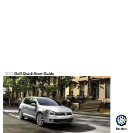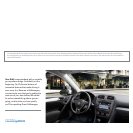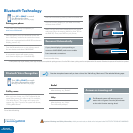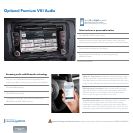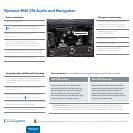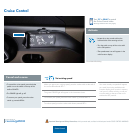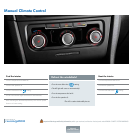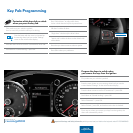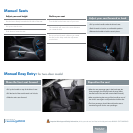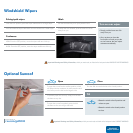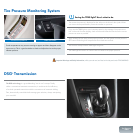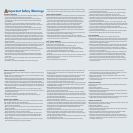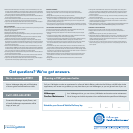
LEARN MORE AT
vw.com/golf2013
Volkswagen
Carefree Maintenance
|
Schedule your Second Vehicle Delivery by:
| |
Month Date Year
Visit our Volkswagen blog and you’ll find plenty
of how-to guides and maintenance videos.
Go to vw.com/golf2013
Contact the Volkswagen Loyalty Center, and
a friendly Volkswagen representative will be
happy to assist you.
Call 1-800-444-8982
Got questions? We’ve got answers.
As a Volkswagen driver, you can visit any VW dealer and receive routine maintenance
like oil changes and vehicle inspections from certified techs that speak fluent Volkswagen.
Call your VW dealer to make an appointment for a Second Vehicle Delivery within the first 90 days or 6,000 miles. At the
appointment, we’ll answer any questions you may have about your new Volkswagen, so you can get more out of your car.
Owning a VW gets even better
• Never leave external devices in the doors, on the front windshield, on or near
the area marked “AIRBAG” on the steering wheel, instrument panel, seatbacks,
or between these areas and the occupants. External devices can cause serious
injury in the event of a collision, especially if the airbags inflate.
• Connecting cables of external devices may obstruct the driver. Route cables so
as not to interfere with the driver.
• The armrest can affect the elbow room of the driver and thus cause collisions
and severe injuries. Always keep the armrest closed while driving.
• Injuries can be caused by invisible laser beams if the housing of the CD player
is opened. Have the CD player repaired only by a specialist.
RNS 315 WARNINGS
Distracting the driver from traffic can lead to collisions and injuries. Using the radio
system while driving can distract from traffic.
• Observe legal regulations.
• Always drive attentively and responsibly.
• Setting the volume too high can damage the hearing. This applies especially to
volumes above about 85 decibels.
• Select volume settings so that acoustic signals from the outside are always
audible (for example, the sirens of emergency rescue vehicles).
• Please lower the volume before changing or connecting to an audio source.
Unmounted or improperly mounted external devices can be thrown through the
passenger compartment in the event of a sudden driving or braking maneuver
or a collision, causing injury.
• Never leave external devices in the doors, on the front windshield, on or near
the area marked “AIRBAG” on the steering wheel, instrument panel, seatbacks,
or between these areas and the occupants. External devices can cause serious
injury in the event of a collision, especially if the airbags inflate.
• Connecting cables of external devices may obstruct the driver. Route cables so
as not to interfere with the driver.
• The armrest can affect the elbow room of the driver and thus cause collisions
and severe injuries. Always keep the armrest closed while driving.
• Injuries can be caused by invisible laser beams if the housing of the CD player
is opened. Have the CD player repaired only by a specialist.
SUNROOF WARNINGS
Improper use of the power sunroof can result in serious personal injury.
• Always make sure that no one is in the way of the power sunroof when it
is closing.
• Always take the key with you when you leave the vehicle.
• Never leave children or disabled persons in the vehicle – particularly if they have
access to the vehicle key. Unsupervised use of the remote control vehicle key
makes it possible to lock the vehicle, start the engine, turn on the ignition and
operate the sliding and tilting roof.
• You can still open or close the power sunroof for several minutes after you switch
off the ignition, as long as the driver or front passenger door has not been opened.
TIRE PRESSURE MONITORING SYSTEM WARNINGS
Incorrect tire pressures and/or underinflation can cause sudden tire failure, loss
of control, collision, serious personal injury or even death.
• When the warning symbol appears in the instrument cluster, stop and inspect
the tires.
• Incorrect tire pressure and/or underinflation can cause increased tire wear and
can affect the handling of the vehicle and stopping ability.
• Incorrect tire pressures and/or underinflation can also lead to sudden tire failure,
including a blowout and sudden deflation, causing loss of vehicle control.
• The driver is responsible for the correct tire pressures for all tires on the vehicle.
The recommended tire pressure values are listed on a sticker inside the
driver door.
• The TPMS can only work correctly when all tires on the vehicle are filled to the
correct cold-tire inflation pressure specified for the tires installed on the vehicle.
• Using incorrect tire pressure values can cause accidents or other damage. Check
the pressure in all 4 tires when the tires are still cold. Never reduce air pressure in
warm tires to match cold-tire inflation pressure.
• Always inflate the tires to the correct specified cold-tire pressure values for the
tires installed on the vehicle; see the tire inflation pressure label on the driver
door jamb.
• Always inflate tires to the recommended and correct tire pressure before
driving off.
• Driving with underinflated tires causes them to flex (bend) more, letting them
get too hot, resulting in tread separation, sudden tire failure, and loss of control.
• Excessive speed and/overloading can cause heat build-up, sudden tire failure
and loss of control.
• If the tire pressure is too low or too high, the tires will wear prematurely and the
vehicle will not handle well.
• If the tire is not “flat” and you do not have to change a wheel immediately, drive
carefully and at reduced speed to the nearest service station to check the tire
pressure and add air as required.
• When replacing tires or wheel rims on vehicles equipped with TPMS always read
and heed the information and all WARNINGS regarding tires and wheels.
WINDSHIELD WIPER WARNINGS
Improper use of the power sunroof can result in serious personal injury.
• Always make sure that no one is in the way of the power sunroof when it
is closing.
• Always take the key with you when you leave the vehicle.
• Never leave children or disabled persons in the vehicle – particularly if they have
access to the vehicle key. Unsupervised use of the remote control vehicle key
makes it possible to lock the vehicle, start the engine, turn on the ignition and
operate the sliding and tilting roof.
• You can still open or close the power sunroof for several minutes after you
switch off the ignition, as long as the driver or front passenger door has not
been opened.



